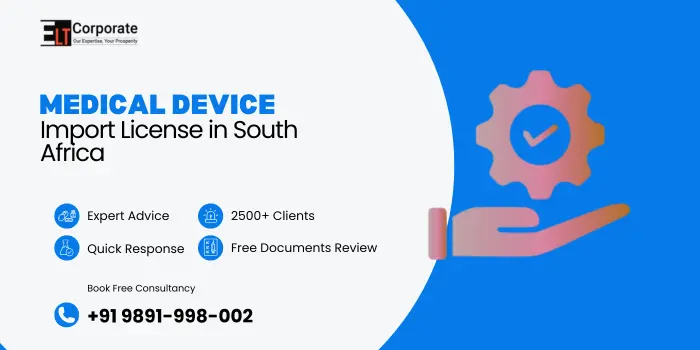In South Africa, medical devices and in vitro diagnostics (IVDs) are regulated by the South African Health Products Regulatory Authority (SAHPRA) under the Medicines and Related Substances Act, 1965 (Act 101 of 1965). If you want to import medical devices into South Africa, you must obtain a Medical Device Establishment Licence from SAHPRA. This licence ensures that devices entering the country meet safety, quality, and performance standards, and that the importing company is properly equipped to handle them in compliance with legal requirements.
Below are the processes, requirements, and steps you need to follow, in simple language.
What is a Medical Device Import Licence in South Africa under SAHPRA?
A Medical Device Licence in south africa (sometimes called an establishment licence for distributors/importers) is the official authorisation from SAHPRA that allows a company to import, distribute, export, or handle medical devices and IVDs in South Africa. Without this licence, importing or selling medical devices is illegal.
SAHPRA issues establishment licences for different types of activities: manufacturing, distributing (import/export), and wholesaling.
Why is this licence important?
- It ensures that all medical devices entering the South African market comply with safety and quality standards, protecting patients and users.
- It provides legal legitimacy for the importer/distributor; SAHPRA oversight helps maintain trust and avoids penalties for non-compliance.
Which types of devices require this import licence?
Any medical device (or IVD) that falls into risk classes B, C, or D always requires a SAHPRA establishment licence to import, distribute, or export. Class A devices are exempt in certain cases (non-sterile, non-measuring Class A) from licensing.
What are the Eligibility Criteria/Prerequisites?
To apply for the import licence, you must satisfy several prerequisites:
- Be a legal entity in South Africa and have a physical business address.
- Have or appoint an Authorised Representative in South Africa. That person is responsible for regulatory compliance.
- For riskier classes (C & D), you must provide proof of premarket approval or registration from a recognised regulatory jurisdiction (e.g. EU, FDA, TGA, WHO prequalification) for the device.
- Maintain a Quality Management System (QMS). SAHPRA requires ISO 13485 certification (or evidence of pursuit of certification), especially for renewing higher risk-class licences.
What are the Documents Required for the Import Licence Application?
When applying to SAHPRA to import medical devices or IVDs, you’ll need to prepare and submit several documents:
- Completed application form for licence (for import/distribution/export) – SAHPRA provides specific forms.
- Detailed list of all devices you intend to import, with their risk class and Global Medical Device Nomenclature (GMDN) codes.
- For medium-to-high risk (Class C & D) devices, proof of originating approval or registration from a recognised regulator or WHO prequalification.
- Certificate of Free Sale from the country of manufacture or final assembly for devices in certain risk classes.
- Company’s quality management certificates (e.g., ISO 13485) or evidence of ongoing certification.
- Labelling, Instructions for Use (IFU), safety/performance data, and technical documentation as needed.
What is the Process/steps to apply for the Import Licence?
Here’s a step-by-step process:
- Classify device: Determine risk class (A, B, C, or D) under SAHPRA’s Medical Device Classification Guideline.
- Prepare documents: Assemble all required documentation (device listing, approvals, QMS, safety data).
- Fill application form: Use SAHPRA’s import/distribution/export licence application form (e.g. Form 6.22) or the relevant form.
- Appointed authorised representative: Ensure there is a natural person in South Africa responsible for regulatory compliance.
- Submit application to SAHPRA: Via their system or as per the guideline SAHPGL-MD-06. Pay the required fees.
- Review by SAHPRA: SAHPRA will check documentation, risk classification, approvals, QMS, etc. If required, inspections or audits may be requested.
- Issuance of Licence: If everything is in order, SAHPRA grants the establishment licence, which allows import/distribution.
What are post-licence obligations once you have the import licence?
Once the licence is issued, there are ongoing obligations:
- Maintain compliance with Quality Management System (ISO 13485) and keep that certification current.
- Update SAHPRA if you want to add new device models or import additional risk classes.
- Ensure devices imported meet the approvals/standards declared in the application (labelling, safety, performance).
- Retain technical documentation and evidence for inspections or audits.
- Renew your licence as required. The licence has a validity period, after which renewal is needed.
What Are Fees And Timelines?
Fees and timelines vary depending on the class of the device, complexity, and completeness of documentation. While SAHPRA publishes fees for establishment licences, the actual review time can take several weeks to months, depending on how well the application is prepared.
Common Pitfalls And How To Avoid Them
- Submitting incomplete or mismatched documentation (e.g., missing proof of external approvals).
- Wrong device classification; risk class affects requirements heavily.
- Not having a properly appointed authorised representative in South Africa.
- Delayed or expired QMS certificates.
Failing to provide clear labelling / IFU matching the intended use.
Being thorough in assembling documents and verifying all requirements upfront saves delays.
What Upcoming Changes Or Considerations Are There?
- SAHPRA is moving toward more formal device registration (not just establishment licences), especially for higher-risk devices. There is a “registration call-up plan” for devices to be formally registered.
- Increasing requirement for ISO 13485 certification for renewal of licences.
- Reliance pathways: SAHPRA plans to accept approvals from reference regulatory jurisdictions to streamline safety/performance evaluations.
Can I Import Class A Medical Devices Without A Sahpra Licence?
If a device is non-sterile, non-measuring Class A, it may be exempt from establishment licence requirements under SAHPRA’s current regulations.
Do I Need An Iso 13485 Certificate To Import High-Risk Medical Devices Into South Africa?
Yes. For higher-risk classes (Class C & D), SAHPRA requires proof of ISO 13485 certification or evidence that the process is underway.


Comments are closed